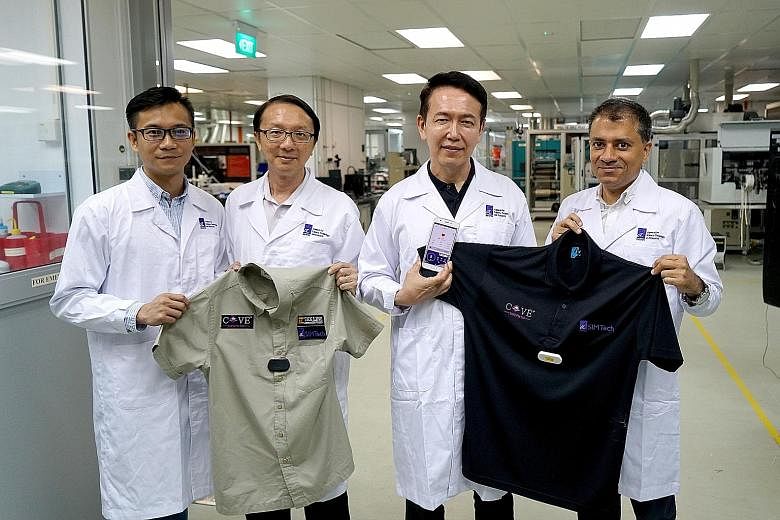Imagine wearing a smart shirt that tracks not only your physical activities, but also your heart rate, electrocardiography (ECG) and maximal aerobic capacity.
That is the future in development here in Singapore.
Currently a prototype, this smart shirt has built-in electrodes and sensors, or flexible hybrid electronics, that transmit data to a detachable smart module. The data that is collected and processed is then shared by the module with a smartphone app.
The smart shirt is the result of a three-party collaboration involving the Agency for Science, Technology and Research (A*Star), Singapore-based smart wearables start-up KaHa and local textile company Tex Line.
Singapore Institute of Manufacturing Technology (SIMTech), a research institute of A*Star, prints the sensors onto the shirt to pick up signals from the body, while KaHa provides the software expertise for raw data to be processed and presented via the app. Tex Line helps to integrate both technologies into the shirt's fabric.
This project stems from A*Star's collaborative industry project (CIP) - a consortium of around 20 companies that was launched in February this year to drive innovation in smart wearables.
Mr Rick Yeo, director of Emerging Applications Centre at SIMTech, said Singapore should not miss out on the next big tech trend, which is wearables.
The total global revenue for wearables will reach US$160 billion (S$217 billion) by 2026, compared withUS$40 billion this year, according to market research firm IDTechEx Research.
To do so, SIMTech is looking at the second generation of wearables, which is going to be clothing-centric, whereas the first generation includes devices likefitness trackers and smartwatches.
Mr Pawan Gandhi, KaHa's chief executive officer, saidhis company approached A*Star with a proof-of-concept design eight months ago.
He had also visited SIMTech's facilities to understand the manufacturing process and experimented with multiple solutions before finally coming up with the prototype design.
With close to 30 years of experience in sourcing and manufacturing apparels as well as sports equipment, Tex Line came in with its clothing expertise. "We jumped into it because this is something we feel would add value to our customers and would aid us in finding new customers," said Mr Justin Tan, Tex Line's product manager.
Previously, Tex Line was looking at understanding how sports sensors are going to affect the apparel business. And this collaboration will help Tex Line to be "ahead when the trend really catches on".
One of the biggest advantages of the smart shirt is that it allows you to monitor your ECG on a daily basis, instead of having to do an annual check-up.
To do so, the shirt needs to be stretchable and washable with the sensors embedded, said Mr Yeo.
Mr Lok Boon Keng, principal research engineer at SIMTech, said the biggest challenge in creating the smart shirt is adopting SIMTech's existing technologies to print the sensors on textiles.
The team is targeting businesses and uniformed groups, but the ultimate target for this smart shirt is the masses. "This is going to be the first (smart shirt) platform from Singapore to reach out to the masses around the world," said Mr Gandhi.
Mr Yeo said the team, together with the Economic Development Board, is in talks with big apparel companies to take the technology overseas.
But for now, it is more focused on product development.
The prototype currently has a visible detachable smart module. But the team assured that this will not be the case for the final product. "We shouldn't be seeing any electronics at all," said Mr Gandhi.
Smart clothing is not new, with many similar developments around the world.
For example, there is Levi's Commuter Trucker Jacket that allows wearers to play music by touching certain parts of the sleeve.
There is also the Hexoskin smart shirt that works like the Singapore prototype, but transmits data to a small device in a shirt pouch.


